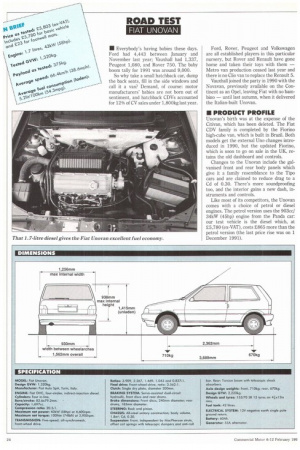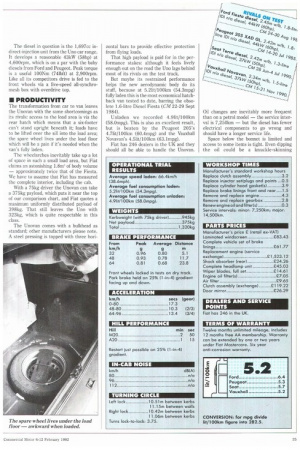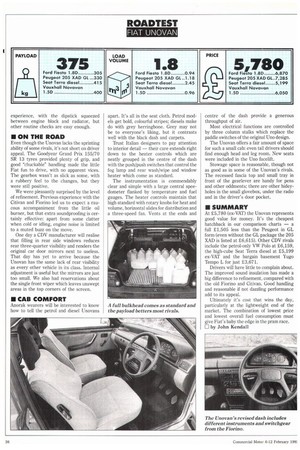ROAD TEST
Page 26

Page 27

Page 28

If you've noticed an error in this article please click here to report it so we can fix it.
FIAT UNOVAN
• Everybody's having babies these days. Ford had 4,443 between January and November last year; Vauxhall had 1,337, Peugeot 1,080, and Rover 750. The baby boom tally for 1991 was around 9,000.
So why take a small hatchback car, dump the back seats, fill in the side windows and call it a van? Demand, of course: motor manufacturers' babies are not born out of sentiment, and hatchback CDVs accounted for 12% of CV sales under 1,800kg last year. Ford, Rover, Peugeot and Volkswagen are all established players in this particular nursery, but Rover and Renault have gone home and taken their toys with them — Metro van production ceased last year and there is no Clio van to replace the Renault 5.
Vauxhall joined the party in 1990 with the Novavan, previously available on the Continent as an Opel, leaving Fiat with no bambino — until last autumn, when it delivered the Italian-built Unovan.
• PRODUCT PROFILE Unovan's birth was at the expense of the Citivan, which has been deleted. The Fiat CDV family is completed by the Fiorillo high-cube van, which is built in Brazil. Both models get the external Uno changes introduced in 1990, but the updated Fiorino, which is soon to go on sale in the UK, retains the old dashboard and controls.
Changes to the Unovan include the galvanised front and rear body panels which give it a family resemblance to the Tipo cars and are claimed to reduce drag to a Cd of 0.30. There's more soundproofing too, and the interior gains a new dash, instruments and controls.
Like most of its competitors, the Unovan comes with a choice of petrol or diesel engines. The petrol version uses the 903cc/ 34kW (4 Slip) engine from the Panda car: our test vehicle is the diesel which, at £5,780 (ex-VAT), costs £865 more than the petrol version (the last price rise was on 1 December 1991).
The diesel in question is the 1,697cc indirect-injection unit from the Uno car range. It develops a reasonable 43kW (58hp) at 4,600rpm, which is on a par with the baby diesels from Ford and Peugeot. Peak torque is a useful 100Nni (741bft) at 2,900rpm. Like all its competitors drive is fed to the front wheels via a five-speed all-synchromesh box with overdrive top.
• PRODUCTIVITY
The transformation from car to van leaves the Unovan with the same shortcomings as its rivals: access to the load area is via the rear hatch which means that a six-footer can't stand upright beneath it; loads have to be lifted over the sill into the load area; the spare wheel lives under the load floor which will be a pain if it's needed when the van's fully laden.
The wheelarches inevitably take up a lot of space in such a small load area, but Fiat claims an astonishing 1.8m.' of body volume approximately twice that of the Fiesta. We have to assume that Fiat has measured the complete interior, including the cab.
With a 75kg driver the Unovan can take a 375kg payload, which puts it near the top of our comparison chart, and Fiat quotes a maximum uniformly distributed payload of 398kg. That still leaves the Uno with 323kg, which is quite respectable in this class.
The Unovan comes with a bulkhead as standard; other manufacturers please note. A steel pressing is topped with three hori
zontal bars to provide effective protection from flying loads.
That high payload is paid for in the performance stakes: although it feels lively enough out on the road the Uno lags behind most of its rivals on the test track.
But maybe its restrained performance helps the new aerodynamic body do its stuff, because at 5.21it/1.00km (54.3mpg) fully laden this is the most economical hatchback van tested to date, barring the obsolete 1.6-litre Diesel Fiesta (CM 22-29Sept 1984).
Unladen we recorded 4.91it/100km (58.0mpg). This is also an excellent result, but is beaten by the Peugeot 205's 4.71it/100km (60,4mpg) and the Vauxhall Novavan's 4.51it/100km (63,1mpg), Fiat has 246 dealers in the UK and they should all be able to handle the Unovan.
Oil changes are inevitably more frequent than on a petrol model the service interval is 7,250km but the diesel has fewer electrical components to go wrong and should have a longer service life.
Space below the bonnet is limited and access to some items is tight. Even dipping the oil could be a knuckle-skinning experience, with the dipstick squeezed between engine block and radiator, but other routine checks are easy enough.
• ON THE ROAD
Even though the Unovan lacks the sprinting ability of some rivals, it's not short on driver appeal. The Goodyear Grand Prix 155/70 SR 13 tyres provided plenty of grip, and good "chuckable" handling made the little Fiat fun to drive, with no apparent vices. The gearbox wasn't as slick as some, with a rubbery feet to the changes, but they were still positive.
We were pleasantly surprised by the level of refinement. Previous experience with the Citivan and Fiorino led us to expect a raucous accompaniment from the little oil burner, but that extra soundproofing is certainly effective: apart from some clatter when cold or idling, engine noise is limited to a muted buzz on the move.
One day a CDV manufacturer will realise that filling in rear side windows reduces rear three-quarter visibility and renders the original car door mirrors next to useless. That day has yet to arrive because the Unovan has the same lack of rear visibility as every other vehicle in its class. Internal adjustment is useful but the mirrors are just too small. We also had reservations about the single front wiper which leaves unswept areas in the top corners of the screen.
• CAB COMFORT
Anorak wearers will be interested to know how to tell the petrol and diesel Unovans apart. It's all in the seat cloth. Petrol models get bold, colourful stripes; diesels make do with grey herringbone. Grey may not be to everyone's liking, but it contrasts well with the black dash and carpets.
Trust Italian designers to pay attention to interior detail — their care extends right down to the heater controls which are neatly grouped in the centre of the dash with the push/push switches that control the fog lamp and rear wash/wipe and window heater which come as standard.
The instrumentation is commendably clear and simple with a large central speedometer flanked by temperature and fuel gauges. The heater controls maintain that high standard with rotary knobs for heat and volume, horizontal slides for distribution and a three-speed fan. Vents at the ends and centre of the dash provide a generous throughput of air.
Most electrical functions are controlled by three column stalks which replace the paddle switches of the original Uno design.
The Unovan offers a fair amount of space for such a small cab: even tall drivers should find enough head and leg room. New seats were included in the Uno facelift.
Stowage space is reasonable, though not as good as in some of the Unovan's rivals. The recessed fascia top and small tray in front of the gearlever are handy for pens and other oddments; there are other hideyholes in the small glovebox, under the radio and in the driver's door pocket.
• SUMMARY
At £5,780 (ex-VAT) the Unovan represents good value for money. It's the cheapest hatchback in our comparison charts — a full £1,505 less than the Peugeot in GL form (even without the GL package the 205 XAD is listed at £6,615). Other CDV rivals include the petrol-only VW Polo at £6,159, the high-cube Seat Terra diesel at £5,199 ex-VAT and the bargain basement Yugo Tempo L for just £3,671.
Drivers will have little to complain about. The improved sound insulation has made a big difference to refinement, compared with the old Fiorino and Citivan. Good handling and reasonable if not dazzling performance add to its appeal.
Ultimately it's cost that wins the day, particularly at the lightweight end of the market. The combination of lowest price and lowest overall fuel consumption must give Fiat's baby the edge in the pram race. El by John Kendall




































































































